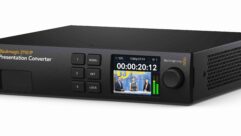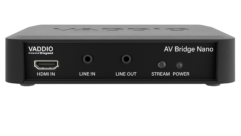Businesses have been leveraging technology to improve productivity and work experience for decades. Until recently, however, this trend applied largely to the use of computer systems and networks but is rapidly expanding into audio and video.
Where are these technologies being used? Everywhere. From lobbies with informative screens, to multimedia corporate event spaces, to fully equipped conference rooms designed for immersive communications, the use of audio and video is increasing in scope and value.
Traditionally, AV was separate from the other resources used in business—not part of the network, and not delivered with tools that could be easily used by employees. It meant calling in a specialist to connect devices and keep them working, using technologies that are not part of the information systems that are the backbone of corporations. Now that’s changing.
The distribution and control of real-time audio and video over a computer network, may initially seem like only a change in medium, but the implications are far-reaching and important to businesses
Unlike legacy AV connectivity systems, AV-over-IP is not beholden to proprietary cables and connectors that are often relegated to short runs between devices. AV-over-IP uses the same network hardware, cables and connectors as all other network gear, from computers to printers to cameras. Networks cover entire campuses with connectivity, and AV-over-IP uses that connectivity to transport audio and video signals to any locations on those networks. Gone are distance limitations, oddball connectors and tiresome workarounds.
AV-over-IP brings a new level of interoperability to AV, leveraging the universal nature of modern networking to allow devices from different vendors to communicate over a common fabric with common protocols and rules. And because AV-over-IP uses common networking methods, it is always fully compatible with the vast marketplace of cost-effective networking hardware.
AV-over-IP lets businesses employ audio and video more easily and more flexibly than legacy methods, allowing them to expand into uses that were previously considered too complex or expensive.
In conference rooms, unified communications systems that can deliver tightly synchronized AV have traditionally been expensive and bespoke, often deterring businesses from investing and limiting the ability of employees to effectively use the system for day-to-day work. AV-over-IP makes these capabilities much less expensive, relying upon the incredible power of common computing devices to provide signal processing and distribution. Easy-touse software interfaces provide users with the clarity they need to use the system as a part of everyday communications.
Likewise, when distributing video to information screens in lobbies and other spaces, earlier proprietary systems often required special hardware and careful setup. AV-over-IP puts more power in the hands of everyday users, letting them send audio and video to many endpoints at once with a click over the network that’s already in place.
Importantly, AV-over-IP brings the IT department to the AV party. Or vice versa. IT is responsible for the data and systems upon which businesses thrive, and communications is most certainly a part of that scope. In the past, IT departments were helpless to aid a user whose proprietary conferencing system had failed—with AV-over-IP, those systems are online and completely manageable by IT, just like the other connected devices on the network. AV-over-IP moves AV from being a mysterious “black box” to something that is easily understood by the people already on staff.
Audio networking is, by now, firmly established in the industry, and there are thousands of fully interoperable products available on the market. Video is much newer, and while it works in the same fashion, requires far more bandwidth than audio. Fortunately, modern networks are nearly entirely built on gigabit-speed switches and can easily accommodate these traffic types.
There are already thousands of networked audio products available, and new IP video products are rapidly coming online. Some providers of AV-over-IP technology provide searchable catalogs to help integrators and designers choose among interoperable products.
The future of corporate AV is most certainly on the network—along with everything else in modern business.









